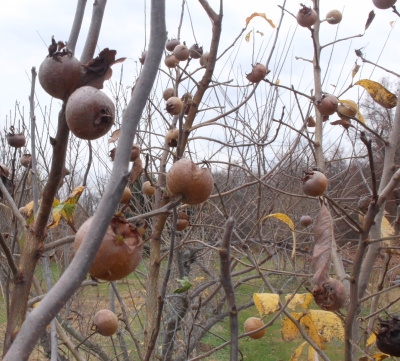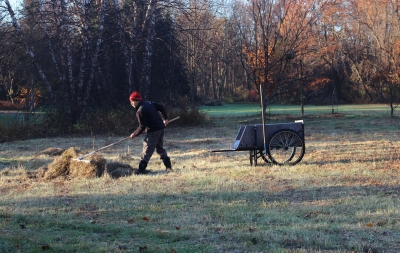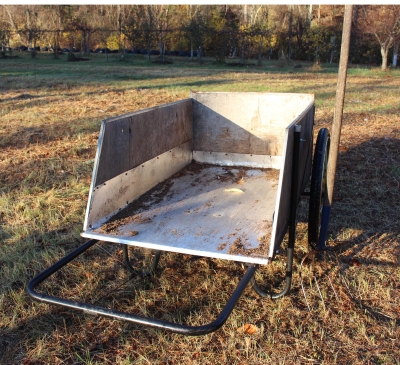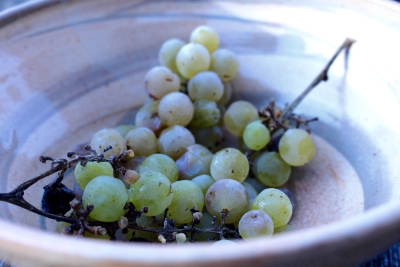THE UGLY, THE TASTY, & THE BEAUTIFUL
/7 Comments/in Design, Fruit/by Lee ReichClose Your Eyes, If Necessary
“A crabby looking, brownish green truncated little spheroid of unsympathetic appearance.” That’s how a British writer of almost 75 years ago described one of my favorite fruits, medlar (Mespilus germanica). True, the fruit is no beauty to some eyes. To me, the fruit has an authentic, old-fashioned, unvarnished look to it, like that of a small, russeted apple whose calyx end (opposite the stem) is flared open.
Medlar is truly an old-fashioned fruit, whose popularity peaked in the Middle Ages. Chaucer mentioned it, indecorously referring to it as “open arse.” Even Shakespeare got his digs in, more discretely call it “open et cetera.”
This past season was a good season for fruits, including medlar. Yesterday, I harvested the crop from the leafless tree. But no, I couldn’t yet sink my teeth into one. Besides its odd appearance, medlar has one more quirk: The fruit needs to be bletted before being eaten. During the bletting process, at cool room temperatures for a couple of weeks, the white, rock-hard interior of the fruit turns to brown mush. A delectable brown mush, much like a very rich applesauce with wine-y overtones.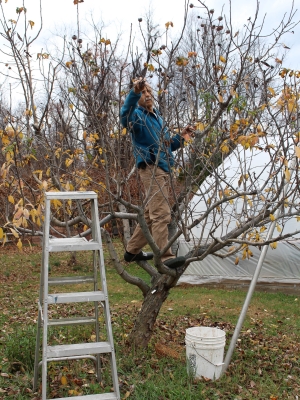 Past writers have also gotten their digs in mocking the required bletting, as if it was akin to rotting. But banana, avocado, and European pears also require post-harvest softening before they are ready to eat. Admittedly, not softening AND browning, which might look like rot, but actually, with medlar, indicates an increase in sweetness and a decrease in acids and tannins. British wine connoisseur George Saintsbury considered medlar the ideal fruit to accompany wine; D. H. Lawrence considered medlars “wineskins of brown morbidity.”
Past writers have also gotten their digs in mocking the required bletting, as if it was akin to rotting. But banana, avocado, and European pears also require post-harvest softening before they are ready to eat. Admittedly, not softening AND browning, which might look like rot, but actually, with medlar, indicates an increase in sweetness and a decrease in acids and tannins. British wine connoisseur George Saintsbury considered medlar the ideal fruit to accompany wine; D. H. Lawrence considered medlars “wineskins of brown morbidity.”
I like the fruit and look forward to drawing out the season by refrigerating portions to delay bletting.
Now Open Your Eyes
Whether or not the fruit is considered ugly and uncouth, the medlar plant has much to recommend it. It’s the perfect multi-use tree for a small yard.
Where space is limited, no need to choose between whether to plant an ornamental or a fruit tree, because medlar is both. The elbowed contortions of the branches, more evident now that the plant has dropped its leaves, lend an air of rusticity. Come spring, white blossoms, each a couple of inches across and every bit as showy as a wild rose, unfold after the plant has pushed out a few inches of growth. A whorl of dark green leaves behind each flower contrasts and frames the blossom.
Each of those blossoms will generally morph into a fruit. No additional tree is needed for pollination — another plus for small yards.
And this is a small tree, so fits well into a small yard. My tree, in rich soil and over ten years old, is only about eight feet high and wide.
(For more on the history, cultivation, and varieties of medlar, see the chapter on this fruit in my book Uncommon Fruits for Every Garden).
More Eye Candy
As I walked back to my medlar tree, harvest basket in hand, other fruit plants, my blueberry bushes, caught my attention, these solely for their beauty. Blueberries offer some kind of “eye candy” in every season, with sprays of urn-shaped, white flowers in spring and slightly bluish, green leaves that look spry all season long.
Autumn is blueberry’s showiest season, when the leaves usually come alive with a crimson color that rivals that of burning bush, a shrub grown solely for its autumn show. This month, the blueberry bushes look finer than they ever have, with some of each bush sporting golden yellow leaves, some orange leaves, and some crimson leaves.
I’m going to attribute this year’s blueberry spectacular to the weather. Leaves’ crimson color is due to anthocyanins, which need sugars to develop. Warm, sunny days foster photosynthesis and sugar production but the relatively warm night’s of this season burn up those sugars. Carotenoids are responsible for the oranges and yellows of leaves. They’re always present, and my theory is that, with warm nights, less anthocyanin was present to mask them.
Even after leaf drop, blueberries have something to offer, visually, when cold weather turns the stems red (perhaps less this year because of less anthocyanins?). This winter, I’ll enjoy whatever the plants have to offer, along with last season’s berries, now in the freezer.
SUSTAINABLE DIRT
/13 Comments/in Gardening, Planning, Soil, Tools, Vegetables/by Lee ReichDirt is Free, Almost
Sustainability is such a buzzword these days. Okay, I’ll join the crowd and say, “I’m growing fruits and vegetables sustainably.” But is this true. Can they really be grown sustainably, that is, in such a way to be able to continue forever?
As any plant grows, it sucks nutrients from the soil. Harvest the plant and you take those nutrients off-site. Eventually, those nutrients need replenishment. That’s what fertilizer does, but spreading fertilizer — whether organic or chemical — is hardly sustainable. Organic fertilizers, such as soybean meal, need to be grown, harvested (taking nutrients off site), processed, bagged, and transported. Chemical fertilizers need to be mined and processed, or manufactured, and then also bagged and transported.
About half the volume of most soils is mineral, the rest being air, water, and organic matter. The mineral portion derives from rocks that, with time, temperature changes, and the jostling and chemical action of plant roots, fungi, earthworms, and other soil microorganisms, are ground finer and finer. Plant nutrients once locked up in those rocks become soluble and available to plants. Over time, a soil naturally offers a pretty much unlimited supply of plant nutrients. That sounds sustainable . . . but wait; three important caveats.
First, it takes time to release those nutrients. Remove too much too fast and it’s like taking money out of the bank faster than you put it in.
Second, one very important nutrient, nitrogen, does not come from rocks. It comes from the air, “fixed” by soil microorganisms, then incorporated into plants. As plants die, the nitrogen is incorporated into the organic fraction of the soil, from which it is slowly released into the ground for other plants to use — unless it washes away or becomes a gas again. Nitrogen is the most evanescent of plant nutrients.
And third, a soil could be naturally lacking in one or more essential plant nutrients. If so, the deficiency needs to be corrected by bringing in and spreading what’s needed.
Hay, Time, & a Little Manure
Okay, here’s my stab at sustainability: My vegetables get “fed” only compost, a one-inch depth laid on top of each bed each year. This much compost releases enough nitrogen, as well as other nutrients, to keep plants happy and healthy for a year.
But the sustainability meter must examine what goes into the compost. The bulk of my compost is made from hay harvested from my one acre hayfield. Here’s the rub: If I harvest the hay too frequently, I’m mining the soil, pulling out nutrients faster than they are naturally replenished. So I focus on different parts of the field in different years, giving previously harvested portions time to rejuvenate.
Early morning forays into the field with my scythe provide enough hay for compost making during the growing season. Last week, I did what I do each fall, attaching the brush hog to my tractor and mowing the whole field. (Mostly, this prevents the field from morphing over time, first to a field of brambles, multiflora roses, and autumn olives, and then on to forest.) After brush hogging, I rake up a few clumps of hay here and there for the final “feeding” of the season’s compost piles.
This end-of-season stuff is not very nutrient-rich, so what little I harvest takes little from the field in terms of nutrients. This cutting mostly supplies carbon compounds, which it got from via photosynthesis from carbon dioxide, to feed the compost microorganisms.
Keeping an eye on the character of the hayfield should give me some idea of how it’s doing nutritionally. More grasses, more nutrients. Areas of goldenrod, yarrow, and other forbs get mowed, but not raked.
My compost pile also gets fed horse manure that I haul in from a local stable. My use of manure is sustainable only in the sense that it’s someone else’s waste product. Other additions to my compost pile are kitchen scraps and spent garden plants (which recycles rather than adds nutrients), and old blue jeans and other biodegradable clothing. Using humanure (see The Humanure Handbook by Joseph Jenkins), if I had a composting toilet, would further close the nutrient cycle.
Two final additions, sustainable except that they need to be transported here, are ground limestone and kelp. The limestone holds soil acidity near neutral, which, among other benefits, puts nutrients in forms most accessible to plants. The kelp, replete with a spectrum of micronutrients, is for insurance, just in case my soil naturally lacks any essential plant (or human) nutrient.
And Now for the Cart’s Sustainability
Hay is bulky stuff; same goes for manure. I move all that bulky stuff to my compost piles, then move the finished compost away from the piles. All this moving is done with the help of my “Vermont garden cart,” which has two heavy duty, bicycle-sized tires sitting just about midway across a sturdy plywood bed surrounded by three sturdy plywood walls. Although the cart can haul up to 400 pounds, shoveling out manure or compost scrapes away at the plywood base. That, along with jabs from the pitchfork as I pile in hay severely compromised the wood . . . until this summer.
A sheet of aluminum, a friend’s brake for making sharp bends in the sheet, and some screws, and I had the bottom of the cart, and a few inches up each side, protected from my shovel, pitchfork, and moisture. These carts should be sold already aluminized.
The only problem is that aluminum is very unsustainable. Although abundant, enormous amounts of electricity are required to free it from the raw material, bauxite. On the plus side, aluminum is very long-lasting; I’ll never have to replace it in my carts.
SWEET ANNIE AND SWEET GRAPES
/2 Comments/in Design, Flowers, Fruit, Gardening/by Lee ReichAnnie Helps the World
Sweet Annie (Artemisia annua): such an unassuming name. Likewise for the plant itself, with its ferny, but not distinctive, foliage, and flowers not worth a second look. You’d hardly peg this plant as a player in global health and global warming.
But look within the leaves and you find artemisin, a biologically active compound that has contributed to Sweet Annie’s figuring into Chinese herbal medicine for the past 2,000 years. Artemisin was isolated from the plant in the 1970s by Chinese scientist Tu Youyou, for which she shared a Nobel Prize. Sweet Annie’s uses in Chinese medicine — qinghao in Chinese — run from treating asthma to skin diseases to stomach pain to rheumatism to . . . but not all such claims have been experimentally verified (and Sweet Annie could have bad side effects).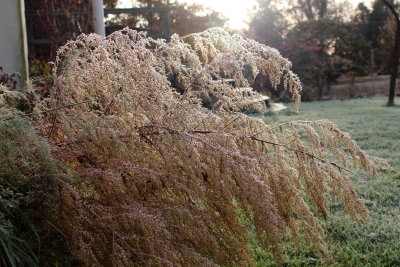
The most widespread and thoroughly documented use of Sweet Annie is, in combination with other drugs, in the treatment of malaria, a disease responsible for over a half a million deaths per year. One roadblock to the more widespread use of artemisin is its cost.
Which brings us to global warming, or, more specifically, the increasing concentration of carbon dioxide in our atmosphere, which is one cause for global warming. Carbon dioxide, for all its bad press, is one ingredient in the recipe for photosynthesis. The carbon in carbon dioxide is what becomes the organic carbon in a plant’s cellulose, starches, sugars, fats, proteins, and other essential building blocks that store energy and build a plant’s physical structure. More carbon dioxide in the atmosphere could translate into greater growth, although increased temperatures from global warming could have the opposite effect.
In the case of Sweet Annie, research by the USDA indicates that a more carbon dioxide rich future would lead to more growth, which translates to greater yields of Sweet Annie and more artemisin for treating malaria.
Annie, for Sweet Aroma
My two Sweet Annie plants aren’t destined for drug production. They’re for olfactory pleasure. Tied into bundles and hung in the mudroom alongside the front door, the bundle will effuse its camphor-sweet aroma each time a breeze or a person brushes past.
Annie’s a Weed?!
Sweet Annie is a self-seeding annual that, like some other members of the wormwood family, can become weedy. Which makes it perhaps unwise that I planted it where I did.
 Garden areas closest to my front, back, and side doors are the ones that get most care and that I look at the most; these considerations guide my plantings, both for aesthetics and for pragmatism. Things get wilder as you move further from the house, the most dramatic example of which is the meadow that begins where the lawn ends.
Garden areas closest to my front, back, and side doors are the ones that get most care and that I look at the most; these considerations guide my plantings, both for aesthetics and for pragmatism. Things get wilder as you move further from the house, the most dramatic example of which is the meadow that begins where the lawn ends.
So it was perhaps foolish to plant Sweet Annie, which is not much to look at and could become weedy, in the bed next to my terrace. Having the fragrant leaves close by was one rationale. But for some reason, that one bed is cared for the least, perhaps because or perhaps consequently it has become a dumping ground for miscellaneous plants for which there are no obvious homes.
That bed is also home to chamomile. Again, one rationale was to have it nearby so I could conveniently pluck flower heads for tea — which I do. But really, no other home presented itself. I planted chamomile there many years ago and got scared of its seeding all over the place. With diligence, I was able to get rid of it — until this year, when I replanted it. I’ve been warned (by myself).
I even planted mint in that bed, again, to have it handy for tea, but knowing how it could, and once did, knit the soil, just beneath the surface, with its lacework of stolons from which sprouts new stems. I did have the foresight, this time, to contain the roots by planting the mint into a chimney flue sunk into the ground. Constant attention will be needed to prevent the stems from flopping down over the sides of the flue to root — which they do very easily — where they touch soil.
From today’s perspective, a handy little garden overflowing with sweet aromas is appealing. I’ll see how I feel next year at this time.
Sweet Ice Grapes
Hanging from vines on the arbor over the terrace are remnants of the season’s grapes and the white paper bags that protected some of the bunches. I found a few bags still with unharvested clusters, frozen but still intact. “Ice grapes,” the precursor to “ice wine,” except that these are eating grapes. They were smooth, sweet, and flavorful.

